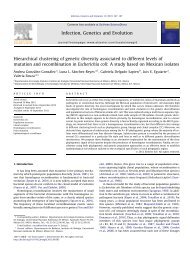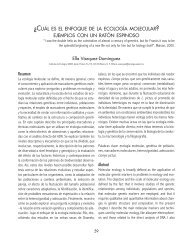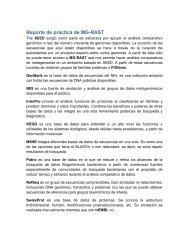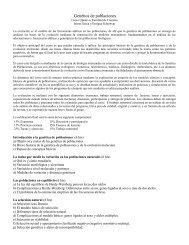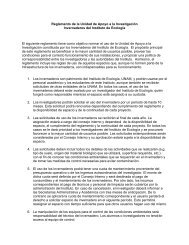Capitulo 11 Plantas - Instituto de Ecología - UNAM
Capitulo 11 Plantas - Instituto de Ecología - UNAM
Capitulo 11 Plantas - Instituto de Ecología - UNAM
You also want an ePaper? Increase the reach of your titles
YUMPU automatically turns print PDFs into web optimized ePapers that Google loves.
230DIVERSIDAD BIOLÓGICA DE SONORArrollo urbano se localizan en las zonas bajas <strong>de</strong> la partecentral y occi<strong>de</strong>ntal <strong>de</strong>l estado. La región serrana <strong>de</strong>mayor altitud <strong>de</strong> la porción este <strong>de</strong>l estado está menospoblada, pero la tala generalizada y las operacionesmineras han impactado los bosques tropicales y <strong>de</strong>montaña. El uso <strong>de</strong> leguminosas como mezquite (Prosopis)y palo fierro (Olneya) para producir carbón y eltallado <strong>de</strong> figuras <strong>de</strong> ma<strong>de</strong>ra y la explotación <strong>de</strong> encinos(Quercus) para la producción <strong>de</strong> papel y carbón,representan usos no sustentables <strong>de</strong> especies importantes.El <strong>de</strong>smonte <strong>de</strong>l matorral espinoso para la agricultura<strong>de</strong> gran escala y la construcción <strong>de</strong> granjas camaronerasen los estuarios ha impactado dramáticamentelas áreas costeras con alta riqueza biológica. Los <strong>de</strong>sarrollosturísticos en las playas <strong>de</strong>l Golfo <strong>de</strong> Californiay la construcción <strong>de</strong> la nueva carretera costera aceleraránel <strong>de</strong>sarrollo costero y, en consecuencia, la pérdida<strong>de</strong>l hábitat.La flora <strong>de</strong> Sonora tiene relativamente pocas especiesno nativas (246 taxones, 6.7% <strong>de</strong> la flora). Lamayoría son <strong>de</strong> las familias Poaceae (68 taxones), Brassicaceae(19 taxones), Fabaceae (15 taxones) y Asteraceae(14 taxones) y en su mayoría son hierbas (83.1%),especialmente anuales (140 taxones). La mayoría <strong>de</strong>estas especies (75.1%) son <strong>de</strong> Eurasia y África y lasmenos (67 taxones) provienen <strong>de</strong>l Nuevo Mundo, <strong>de</strong>s<strong>de</strong>México a América <strong>de</strong>l Sur. Sólo 15% <strong>de</strong> las especies nonativas (37 taxones) se consi<strong>de</strong>ran invasoras con potencialpara dañar los hábitats naturales. Las especiesinvasoras más preocupantes son la mostaza <strong>de</strong>l Sahara(Brassica tournefortii), los zacates mediterráneo y árabe(Schismus arabicus, S. barbatus) en el noroeste <strong>de</strong>l DesiertoSonorense, el zacate buffel (Pennisetum ciliare)en el matorral <strong>de</strong>sértico <strong>de</strong>l centro, la costa y norte <strong>de</strong>Sonora, el matorral espinoso <strong>de</strong> pie<strong>de</strong>monte en la regióneste-centro y sur <strong>de</strong>l estado y el zacate africano(Eragrostis lehmanniana) y el zacate rosado (Melinis repens)en el pastizal <strong>de</strong>sértico <strong>de</strong>l este y norte <strong>de</strong>l estado.Creemos que cada día es más urgente la conservacióny manejo <strong>de</strong> áreas naturales protegidas, la protección<strong>de</strong> especies raras y amenazadas, la vigilancia y control<strong>de</strong> especies exóticas e invasoras y una educaciónambiental <strong>de</strong> calidad conforme la población humanasigue creciendo y aumenta la urbanización y la <strong>de</strong>strucción<strong>de</strong> hábitats.ABSTRACT. The flora of the state of Sonora with anarea of 184 934 km² presently inclu<strong>de</strong>s 3 659 specificand infraspecific taxa documented by herbarium specimens,188 families, and 1 107 genera. In the 3 483species (3 237 native), there are 104 additional varieties,43 additional subspecies, and 30 hybrids betweenspecies. Only 78 taxa (68 species, 8 subspecies, and 2varieties in 26 families) are en<strong>de</strong>mic to mainland Sonora.Families with the largest numbers of en<strong>de</strong>mictaxa are the Cactaceae (13), Asteraceae (12), and Agavaceae(<strong>11</strong>, 9 Agave). En<strong>de</strong>mism is low (2.3% of the 3413 native taxa) because Sonora is a political unit, andmost biotic communities and many quasi-en<strong>de</strong>mics extendinto adjacent states or onto islands in the Gulf ofCalifornia.The plant diversity of Sonora reflects the interminglingof major biogeographic provinces. The New Worldtropics reaches its northernmost limit in North Americain eastern Sonora. Many wi<strong>de</strong>spread tropical speciesreach their northern limits near Álamos in southernSonora in tropical <strong>de</strong>ciduous forest, which extends to28° 35’ N in the Sierra San Javier. Foothills thornscrub(FTS) extends to 30° 30’ N in the Rio Bavispe drainage,with some tropical plants and animals followingthe northern tributaries of the Río Yaqui into southeasternArizona. Other tropical species reach their northernlimits in the coastal thornscrub-Sonoran Desert transitionnear Guaymas (ca. 28° N) or in isolated populationsin canyons and on mountaintops within the <strong>de</strong>sert.Many plants reach their western limits in the FTS-Sonoran Desert transition in east-central Sonora andin montane forests in the Sierra Madre Occi<strong>de</strong>ntal(SMO) in eastern Sonora. Many plants reach theirsouthern limits in Sonora including temperate speciesin the isolated sky island mountains in the northeastand the SMO in the east, and Sonoran Desert species inthornscrub on the coastal plain in southern Sonora.Desert grassland and Chihuahuan <strong>de</strong>sertscrub plantsare reaching both their southern and western range limitsin northeastern and north-central Sonora.A total of 58 Sonoran plants are legally protectedby the Mexican government in the NOM-059-ECOL-2001(NOM, 2002) as E (extinta, extinct), P (en peligro, in dangerof extinction), A (Amenazada, threatened), and Pr(protección, special protection). The list needs revisionbecause: 1. New information indicates species aremore common, more wi<strong>de</strong>spread, or not as threatenedas previously thought. 2. The varieties of species havedifferent conservation needs. 3. Taxonomic names needto be updated. 4. Some Pr species are not rare or threatened,but need to be managed as resources and regulatedun<strong>de</strong>r different legislation. 5. Many regional plants,



